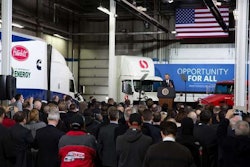
Truck, engine and body makers, along with buyers and operators, are strongly encouraging government regulators to consider real-world operating factors in the development of the next round of medium- and heavy-duty vehicle fuel efficiency standards.
The discussion comes by way of comments filed recently with the National Highway Traffic Safety Administration. NHTSA, together with the Environmental Protection Agency, has initiated development of Phase II of its greenhouse gas standards for trucks. The initial standards became effective Jan. 1 for model year 2014 vehicles, and these are set to be strengthened with model year 2017. Phase II would target 2018 and beyond.
In its response, NTEA, the Association for the Work Truck Industry, writes that the Phase I approach “seems appropriate” and the regulations “seem to be feasible.” To extend that approach for Phase II “seems to be the most logical course.”
But that’s easier said than done, as NTEA discusses.
NTEA suggests that Phase II continue to focus on the drive train.
“While there are an almost infinite number of end-use vehicle configurations (particularly in the vocational vehicle category) being produced by more than 1000 final stage manufacturers, the number of engine configurations and OEM’s is limited,” the association writes, and it offers some figures:
The NTEA’s membership roster and directory lists over 140 distinct body types, at least 100 of which would be applicable to the proposed weight range. This means that there are at least 3,000 distinct chassis and body configurations likely to be affected by the proposed regulation. Any one of close to 1,000 final stage manufacturers could be producing these trucks.
“The almost endless variety of truck chassis, engine, body and equipment combinations that are available in the marketplace exist for the sake of efficiency,” NTEA explains. “Anyone buying this type of trucks is doing so to accomplish a job – whether it is for public service (state, federal municipal) or business.
“The marketplace has always demanded efficiency and has embraced technological change that reduces operating cost. It is our hope that this analysis serves to enhance this economic process and not hinder it.”
The Volvo Group and Daimler Trucks North America likewise discuss the diversity of the truck market, and particularly the vocational segment.
“With such a range of diversity, it is reasonable to conclude that the negative consequences of optimizing the vehicle to more far-reaching regulatory requirements may outweigh any real world benefits,” Volvo says, also proposing that to maintain the current Phase 1 regulation without changes may be the optimum approach for the work trucks.
DTNA notes several critical factors for consideration in Class 2B/3 trucks:
- If regulations make fuel efficient vehicles too expensive for customers and their business, the goal of reducing GHG emissions and fuel consumption reduction will not be achieved.
- To cover additional costs for fuel saving technologies a high yearly mileage is needed. Alternative drivetrains are typically beneficial in urban locations with low mileage. Therefore there is a gap in fulfilling cost-effectiveness, especially regarding alternative drivetrain technologies.
- Downsizing of engines has essentially reached its limit. The Mercedes-Benz Sprinter, for example, is already today equipped with a 2.2 liter in-line diesel engine and further downsizing opportunities, based on required payload and towing weight requirements, are limited.
- Class 2B/3 vehicles are not just bigger cars. Although many components are shared with passenger cars they have to be adapted to the needs of more robust commercial-grade Class 2B/3 vehicles. Especially if payload and towing weights are taken into consideration required torque, power, reliability and vehicle lifetime requirements are very different than passenger car requirements.
- Today there are large differences between the stringency of diesel and the gasoline standards. This is a big disadvantage for the more efficient diesel technology. With current near-zero emission standards, diesel technology does not have disadvantages regarding exhaust emissions.
- Commercial vehicles have very cyclical sales over the course of a model’s product life cycle – sales numbers often swing with the GDP/economy. This has a significant impact on type, efficiency and shape of purchased vehicles.
Engine maker Cummins also calls for “fuel neutral” standards, which have had an impact in the market.
“The Phase I rule adds to the cost of diesels with more stringent standards versus gasoline,” Cummins says. “Should Phase II continue or grow the disparity on CO2 standards between diesel and gasoline, these cumulative higher costs will drive customers away from diesel and toward gasoline, thereby increasing CO2 emissions across the fleet.”
Specialty truck builder Oshkosh Corp. likewise believes that regulating the engine rather than the vehicle is “the only rational approach” to improving the fuel economy of vocational trucks, for many of the same reasons stated by NTEA.
“It is infeasible due to the overwhelming number of configurations to regulate at the body builder level,” Oshkosh says. “Standards at the engine level align well with the existing procedures and practices used today for certification and installation in vocational vehicle designs. The engine manufacturer provides certification, and the small volume vehicle manufacturer can simply follow the installation criteria approved and enforced by the engine supplier.”













